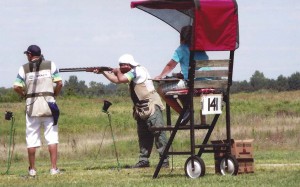by Larry S. Sterett | Contributing Editor
Prior to the start of Preliminary Week of the Grand American Trapshooting Championships at the World Shooting & Recreation Complex (WSRC) north of Sparta, IL, on Aug. 6, the complex fields were filled with younger shooters. The 2014 Scholastic Clay Target Program (SCTP) American National Championships were held in July, followed by the 2014 Grand National Youth Trapshooting Championships Aug. 2-5.
This latter program—AIM for Academics, Integrity, and Marksmanship—is an Amateur Trapshooting Association (ATA) registered event consisting of 200 Singles, 100 Handicap, and 50 Doubles. Other AIM events included a 50 bird International shoot and a 28-gauge shoot, plus free entry into a Shootin’ Showdown. A special AIM benefit fish fry was held on Aug. 8, sponsored by the City of Sparta, which is observing its 175th Anniversary.
The first event of Preliminary Week, on Aug. 6, was the Hodgdon Powder Singles consisting of 100 targets. Events two and three, also held that day were the Trap & Field Handicap consisting of 100 targets at handicap yardage, and the Little Egypt Golf Cars Doubles consisting of 50 pair of targets.
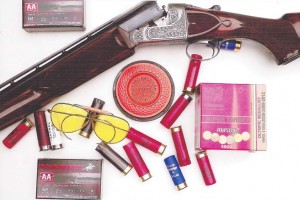
A shotgun, shells, glasses and a 2014 White Flyer target. The Clever Super Target box contains 25 shells, while the two Winchester AA Tracker boxes contain only five shells for a sample trial to permit observation of the wad flight path.
The final Preliminary events included the second half of the NRA Singles (100 targets on Aug. 9, 100 targets the next day, plus the 100 target Blaser Handicap and the 50 pair Wenig Doubles). Blaser is the German manufacturer of fine shotguns, rifles, and drillings, and Wenig produces custom gunstocks in Lincoln, MO.
The really big event, of course, is the Grand American Handicap, shot on Aug. 16. As usual, it had a bit of the unusual. Two competitors, Charles Bickle, of South Elgin, IL, a veteran shooter who had completed a Grand Slam, and Adam Stelkovick, of Avella, PA, with less than two years of competition experience, both broke 100 targets. Hence, a shoot-off was required.
Shooting on an adjacent field, Bickle from the 27-yard line, and Stelkovick from the 18-yard line, both shooters went clean on the first round of 25 targets. On the second round of 25 targets Bickle missed one bird and Stelkovick was clean to emerge as the Grand American Champion for 2014.
Bickle was disappointed with letting the Handicap Championship slip away, but he still had his Grand Slam. A Grand Slam consists of breaking 200 singles targets, 100 doubles targets, and 100 targets from the 27-yard line, all without a miss. As Bickle stated, “It’s disappointing, but it’s still a real good day. I’m still pretty happy about it.”
Stelkovick was only the second shooter to win the Handicap from such a short distance in more than six decades. The last time was in 1952, when Orval Voorhees from Nebraska won the Grand American.
Although Stelkovick could be classed as a novice, his father had shot trap in the past. “My dad was a trap shooter in the early ’80s and he was pretty good. He’s been talking about it his whole life. He was working and had three kids. He couldn’t trapshoot. Last year, we started talking about (it) and we just started doing it. I guess we got the fever.”
While younger shooters have won the Grand American Handicap the past couple of years, it still remains for a woman to win it. The closest was a few years prior to the Grand leaving Vandalia, OH, when a young woman competed in a two-person shoot-off with a more veteran male. As this reviewer recalls, she missed the last bird of the 25. So close!
The first woman Grand American Handicap champion could be Lauren Mueller from Bunker Hill, IL. In her first decade of ‘busting the birds’ the now 21-year-old, who parlayed her shooting ability into a scholarship at Lindenwood University, has been on seven ATA All-American teams. In 2013, Mueller became the first ever woman to take the High-All-Around honors at the Grand American.
Mueller could be termed a ‘natural.’ Within two years of starting her career with a shotgun she made her first All-American team. “I thought it was really cool to make the All-American team at first,” she said. “It didn’t really hit me for a while. I was just out there having fun…a lot of people were super-impressed. It took a while to sink in that people outside this club knew who I was.”
The Grand American Handicap may be the ‘big’ event, but the entire final week is worthwhile. The shooting starts on Monday morning, but the opening ceremonies were not held until 7:00 p.m. that evening. The event did not actually start until 30 minutes after the published hour with the presentation of the colors and singing of the Star Spangled Banner. Immediately following was a flyover consisting of a World War II Mitchell B-25 bomber of the type flown by Jimmy Doolittle on the 1942 raid on Tokyo, and a Grumman TBM Avenger bomber of the type flown by George H. W. Bush in the Iwo Jima area during WWII.
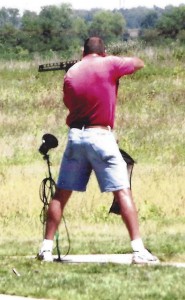
This shooter’s stance may be a bit unorthodox, but it worked for him, as he missed very few targets, and the one in front of him disappeared in a black puff.
Four persons were inducted into the Trapshooting Hall of Fame. William F.J. Fienup born on Dec. 16, 1890, on a farm near New Melle, MO, invented the ‘pop-open’ biscuit can, and eventually became president of the R.C. Can Company, with annual sales of around $31 million in the early 1960s.
Sean Hawley, often called the Prince of Doubles, began trapshooting at the age of 10, and attended his first Grand American at the age of 14, when he won the sub-junior Doubles, All-Around, and High-Over-All titles. Since entering the adult ranks he has captured more than 60 Grand trophies. He completed his ATA Grand Slam in 1992 and his Grand American Grand Slam in 2009.
The names of Bill and LeeAnn Martin should be known to trapshooters not so much for shooting skills, but for their generosity. Bill completed his ATA Grand Slam in 2005, in addition to a Grand Single trophy in 2007 with LeeAnn becoming a 2013 Lady All-American. In 2010 the Martins sponsored the first $100,000 Challenge, where winners of the tournament’s handicap events could compete for a $100,000 cash prize. They continued this for two years and included a woman’s $50,000 shoot-off the final year. They have also helped clubs on a more local level and recently provided $30,000 to the Alberta Trapshooting Association for promotion of trapshooting in the province.
Since selling their oil and gas business seven years ago, they have devoted more time to shooting, but their giving continues. In 2012 they sponsored the $200,000 LeeAnn Martin Lewis Challenge, where all shooters had the chance to take home large cash payouts. At the 2014 Grand it was announced the Martins had contributed $1 million toward construction of the ATA Hall of Fame and Museum on the Sparta grounds. The building is to be located just west of the entrance drive west of the Main Events Building at the WSRC. The site is fenced in and construction of the 9,700-square foot, $1.9 million facility should begin in the near future.
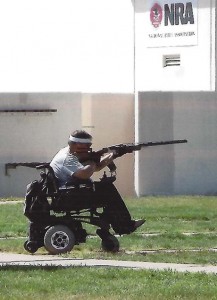
This wheelchair shooter is close to maximum yardage, which means he’s a better shot than many standing shooters.
When asked about being inducted into the Hall of Fame, Bill Martin stated: “It took me by surprise. I’ve got my Grand Slam and I’m a pretty good shot, but not the quality of the Hall of Fame. It’s a great honor. It’s something I never expected to be part of. I’m proud of it. I’ve known a couple other guys that went in as contributors like me. I didn’t do it for that. I was lucky in life. I never got out of eighth grade. I went up to Alaska and made money. I had nothing to do. My brother was shooting trap. I had the money and I could see where they needed money. Kid needed money. I just started paying for it. I don’t know why. My wife and I shoot. It’s a social deal for us. It’s something for an older guy to do. At my age I wasn’t going to run a marathon and I don’t play golf.”
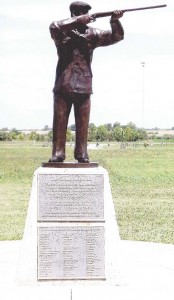
Note this bronze statue honoring the Grand American is using a side/side double barrel hammer shotgun, as commonly used a century ago. Although pump action and autoloading shotguns have been used to win various events over the years, the 1959 Grand American Handicap winner did it with a ‘pre-owned’ Winchester Model 12 shotgun. They are seldom seen on the line anymore.
The ATA Trapshooting Hall of Fame has four new inductees, but the oldest living inductee, and the original Grand Slam shooter, Dan Orlich, also visited the 2014 Grand American for a couple of days. Now in his 90th year, the former defensive and offensive end for the Green Bay Packers was inducted into the Hall of Fame in 1979.
The 2014 Grand American is now in the history books. Attendance seemed to be higher, creeping slowly back up from the low of 27,973 entries in 2008 (The highest participation was the first year in Sparta [2006] when there were 33,858 entries.) Entries do not equal attendance, since one shooter may, and usually does, participate in several events.
The Grand American Trapshooting Championships enjoys worldwide participation. At the 2014 Grand vehicle license plates were noted from most states, plus Alberta, Ontario, Saskatchewan, Manitoba, and Nova Scotia in Canada. (There may have been others not noted.) There were also shooters from Australia, and the Czech Republic. A team from Brazil was in attendance, with the shooters wearing T-shirts featuring sleeves bearing the national colors of blue, green, and yellow, making them easy to spot
The ‘shell house’ was operated by Gamaliel Shooting Supply of Gamaliel, KY. Located in the first building west of the main entrance drive and east of the vendor malls, the shell house was amply supplied with target loads (mainly 12-gauge) from Federal, Remington, Rio, and Winchester, plus a few loads from Clever. A few 20 gauge loads were also being stocked, and purchases could be by the box, or case.
When the Grand America, often called the Prince of Doubles, was in Ohio, all shells used were required to be purchased at the ‘shell house.’ This is no longer so, but only shells loaded with 1-1/8 ounces of shot, or less, to no higher than a 3 dram equivalent may be used. The shot size cannot be larger than 7-1/2, with no minimum size requirement. Most shooters still use shot sizes 7½ or 8, although shells loaded with sizes 8½ or 9 are used by a few shooters. (The local Sam’s WM store in Sparta was also doing a brisk business in cases of shotshells.)
Although most shooters still tend to use Federal, Remington or Winchester brand shotshells specifically factory loaded for competition shooting, there will always be a few mavericks. Estate, Fiocchi, and Rio brand shells are being seen in use more frequently, and shooters at the practice traps vary even more, with handloads sometimes being used. Game, dove and target, clay and field, and sporting clays loads may be noted in use at the practice fields. While the lead shot loaded in game loads used to be a softer alloy than the shot in target loads, the clay targets couldn’t tell any difference. At the 2014 Grand this observer noted a couple of brands—Herter’s and Suprema—in use not observed at previous Grands. The Herter’s shells are loaded in Italy and are conventional folded crimp shells, not the Herter all-plastic case with plastic top wad design introduced by the original Herter firm nearly a half-century ago. The Suprema shells are loaded in Spain and are distributed in the US by a Texas-based firm. They should be good, since Spain is known for its moneyed live pigeon shoots and low quality shotshells would not put you in the winning bracket.
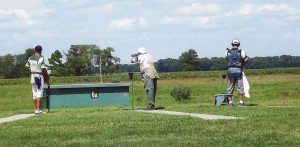 Trap & Field magazine has been labeled the ‘Official ATA Magazine,’ although it was owned and published by a private firm in Indianapolis, IN. Prior to his passing in February, it was the firm’s owner, Dr. B. R. SerVass, desire to see the ATA become the new T&F owners, according to his son, Eric. The acquisition of T&F by ATA is now complete.
Trap & Field magazine has been labeled the ‘Official ATA Magazine,’ although it was owned and published by a private firm in Indianapolis, IN. Prior to his passing in February, it was the firm’s owner, Dr. B. R. SerVass, desire to see the ATA become the new T&F owners, according to his son, Eric. The acquisition of T&F by ATA is now complete.
The Grand American Handicap on the final Saturday is the “big shoot” for many, but not necessarily for the exhibitors. Several vendors begin closing down around noon on Friday and, while foot traffic along the vendor row was reported up, it did not appear so to this observer. There were gaps between a few of the six dozen plus tent vendors behind the east trap line, and foot traffic didn’t seem as heavy there or along the permanent building venders of the west line. Most of the shotguns being exhibited appeared new, and good ‘previously owned’ models seemed few in number. Only two exhibitors seemed to have a fair quantity of the latter available; one had a stock in a trailer behind the east line, and one in a building behind the west traps. (New shotguns, etc. are usually priced at or near the MSRP, but the ‘previously owned’ models may be a bit steeper than expected, or not. It was interesting to note a low priced shotgun which was sold for less than $50 in the early 1950s, and which was discontinued in 1953 for lack of sales, had a used price tag of $1,095.00. The Blue Book lists the same shotgun in ‘as new’ condition for $175.00, if you can find one in said condition. The shotgun had problems.) Handloading supplies and clothing—caps, T-shirts, and shooting jacket/vests—appeared to be moving better than shotguns, and such were definitely easier on the pocketbook.
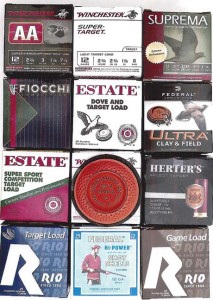
Although shotshells of the Grand American of yesteryear were predominately Federal, Remington, and Winchester, with a few Fiocchi sometimes seen, shotshells at the practice fields tend to be more varied in recent years since the move to Sparta. Note a couple of more unusual—Herter’s and Suprema–among these 2014 boxes.
The 2014 Grand American was probably the best one since the move to Sparta in 2006. Where it was clay and blowing dust, it is now green grass. Most of the early problems have been ironed out, although there is still shuffling around of exhibits, etc. in the Main Entry building. While the first year there appeared to be more Illinois State Police and IDNR personnel than trapshooters visible, that is no longer the case. IDNR agents are on the grounds, but not standing in groups every few yards.
The Grand American Trapshooting Championships in 2015 should be even better than 2014. The new ATA Hall of Fame and Museum is supposed be complete, or nearly so by next August. Except for shade trees, the grounds have shown improvement each year, and the weather couldn’t have been much better than it was for the 2014 Grand—no storms, no 100+ degree days, and no major wind shears to disrupt target flights. The 2014 Grand was in a word, ‘grand.’

